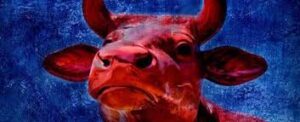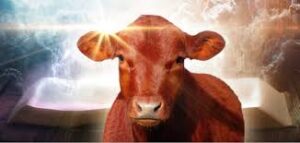The Insufficiency of the Blood of Bulls and Goats
9: 13-14
The insufficiency of the blood of bulls and goats DIG: What was the best the Levitical cleansing could do? What is the significance of the red cow to Isra’el? What message is the writer to the Hebrews sending to those unbelievers in the congregation? Why and when did those washings stop? What is the Temple Institute trying to do? What difference will it make? How is the cleansing of Christ distinguished from the Levitical cleansing?
REFLECT: Is there anything that has become a “holy cow” in your life? How can you get back to worshiping the “holy Messiah?” What is the difference between external and internal cleansing in your life? Do you know someone who needs to hear this?
There are three results of the Messiah’s sacrifice. The first result of His sacrifice was the purification. From early times, every Jewish community has had a mikveh, a pool for ceremonial cleansing. Immersion in its waters is never more important than just prior to Yom Kippur. Being clean before ADONAI is the concern of every true worshipper.
The TaNaKh has many examples revealing mankind’s defilement. Our first parents knew the shame of defilement when they sinned against God’s command (Genesis 3:10).
Aaron and his sons had to wash their hands and feet whenever they drew near to worship YHVH; failure to obey this lasting ordinance would result in death (Exodus 30:17-21).
Concern for purity extended to one’s livestock; ADONAI would not receive a sacrificial offering that was blemished or defective in any way (Exodus 12:5). And only a select group from among the twelve tribes – the priests – could bring those acceptable offerings to Ha’Shem. The high priest alone was permitted to enter the holiest place beyond the Tabernacle’s inner veil, once a year on Yom Kippur, the Day of Atonement (see the commentary on Exodus, to see link click Go – The Day of Atonement).
There was a cleansing, but not enough thorough cleansing. The writer reminds the Hebrews that under the Levitical priesthood the best they could hope for was a limited holiness (Hebrew: kedushah), for the blood of goats and bulls could never really accomplish deep internal cleansing. The Tabernacle was a symbol for the present time, indicating that the gifts and sacrifices being offered there were not able to clear the conscience of the worshiper (9:9).
In addition, there was an extraordinary form of ritual cleansing Moshe was given a regulation that became an increasingly significant part of Isra’el’s worship experience. Numbers 19 describes the ceremony a perfect red heifer (Hebrew: parah adumah), which had never been yoked, and was slaughtered outside the camp of Isra’el. After sprinkling its blood seven times in front of the Tabernacle, the animal was consumed by fire and its ashes stored for mixing with water. This water of cleansing (Hebrew: me niddah) containing those ashes was applied to those who had been defiled as a result of coming near or touching a dead body. The high priest was no exception; he was sprinkled with the purifying waters twice during the week immediately preceding Yom Kippur, just in case he unknowingly became ceremonially defiled.

Oddly enough, this is the only sacrifice where God commands that the ashes of the burnt animal be kept. And this was for a unique purpose as the red heifer was the key sacrifice for purifying the priesthood and their sacred utensils from sin and uncleanliness (see the commentary on Numbers Cy – The Red Heifer). As the Passover lamb was essential to bring our people into covenant relationship with our Heavenly Father, the red heifer was that which kept us cleansed in our service to Ha’Shem.
After the destruction of the Temple and its sacrificial altar in 70 AD, the water for these washings could no longer be made. According to the Oral Law (see the commentary on The Life of Christ Ei – The Oral Law), the last priest to kill a red heifer was the high priest Ishmael ben Phabi ten years before the destruction of Jerusalem. And 12 chapters of the Oral Law (an entire tractate called Parah) are devoted to this strange ritual!
The Samaritans, who viewed Jerusalem’s Temple indifferently, continued slaying red heifers until the fourteenth century, using those ashes for generations afterwards. Maimonides (a twelfth century scholar) believed that the red heifer ritual would be resumed with the coming of the Messiah.
The problem is that this, like so many of Isra’el’s rituals, dealt with the externals of religion. The sometimes elaborate and impressive procedures could not touch the inner defilement that prevented fellowship with the Holy One of Isra’el.233
Speaking to the unbelievers in the messianic congregation the writer says: The blood of goats and bulls and the ashes of red [heifer] sprinkled on those who are ceremonially clean sanctify them so that they are outwardly clean (9:13). Some of the Hebrews in the Diaspora continued to look to the blood of bulls and goats as a means of gaining a right relationship with ADONAI. But that sprinkling only achieved the purifying of the flesh, not the cleansing of the conscience.
There is considerable excitement about the red heifer in Isra’el today. There is an organization called the Temple Institute that is dedicated to establishing the Third Temple. It’s long term aims are to build the third Jewish Temple on the Temple Mount, on the site currently occupied by the Islamic Dome of Rock and reinstate the Levitical sacrifices. Members of the Temple Institute have been working on this for decades.
In order to carry out this project, the Temple Institute has joined forces with an experienced Israeli cattle rancher who is an expert in the science of animal husbandry, under the halakhic supervision and guidance of the rabbis of the Temple Institute. The cattle rancher is utilizing the technique of implanting the frozen embryos of the Red Angus cattle, which originally come from North America and Israeli domestic cattle. The end result of this program will be the introduction of the Red Angus breed into Isra’el. But before we get too carried away, we need to realize that even if the Temple Institute can produce a perfect red heifer, it would still only produce an external cleansing! Thus, the importance of the red heifer sacrifice lies in that it serves as a Torah picture of the cleansing sacrifice accomplished by the Messiah. If on the non-Messianic rabbis would understand this, they would not be in so much darkness about this special sacrifice.
While many seem to be caught up in the recent commotion, a question is posed to those of us, Jews and Gentiles, who believe in Yeshua Messiah. What does all this mean to us? On the one hand, I am sure many believers are also excited that things keep moving closer to the end of the present age. As we see some of these events of the Scriptures come into focus, we realize anew that Mashiach is coming! Yet, I believe we miss an important point if we feel the need for a red cow in order to be cleansed before God. In fact, such excitement about the red heifer seems to imply that Yeshua is not the Messiah and that we must have the cleansing of our sins through the sacrifices of the rebuilt Temple. The New Covenant scriptures remind us of the opposite truth; namely, that Jesus Himself fulfilled the ministry of the red heifer in His first coming to Jerusalem. Significantly, the writer to the Hebrews states: Then how much more will the blood of the Messiah, who through the eternal Holy Spirit offered Himself unblemished to God, cleanse our consciences from works that lead to death, so that we may serve the living God (9:14). The blood of Jesus does exactly what the blood of the red heifer could not do – it cleanses the conscience.
Numbers 19:1-13 points out that the red heifer sacrifice could only cleanse the flesh. Yeshua’s sacrifice, however, could penetrated much deeper – to cleanse our defiled consciences from acts that lead to death. Contact with a physically dead person rendered a person tam’ei, or impure. But here the writer to the Hebrews reveals that our contact with works that lead to death renders all of us unfit to enter God’s presence. What are works that lead to death? They are the works done by a person who is spiritually dead in an attempt to gain spiritual life. It never works (no pun intended)! Only a blood sacrifice can accomplish what is necessary to clear the conscience of a sinner – attempting to do good works is never acceptable to ADONAI, nor does it relieve one’s guilty conscience.
Thus, Messiah’s sacrifice goes beyond the red heifer’s to which He is compared. It does so because the red heifer’s sacrifice could never cleanse a dead soul from his dead works. It only cleansed one from contact with a dead body. Yeshua’s sacrifice provided spiritual cleansing. Just as contact with the realm of death prohibited one form being in the intimate presence of the Holy One, personal “contact” with the realm of spiritual death prohibits the sinner from an intimate personal relationship with God.

Indeed, the death of Yeshua Messiah is a beautiful fulfillment of the symbolism associated with the red heifer. He was sinless and without defect. Like the red heifer, Yeshua’s death took place outside the camp. The ongoing effect of His sacrifice, similar to the ashes of the heifer, cleanses His people for priestly service. As interesting as all the recent events are, it seems Messianic believers, whether they be Jew or Gentile, have even a better reason to be excited. Instead of getting caught up in the “holy cow”, I hope we are more caught up in the “holy Messiah“! Are you ready for His return? Are you fulfilling your calling as a priest cleansed to serve the Living God?



Leave A Comment